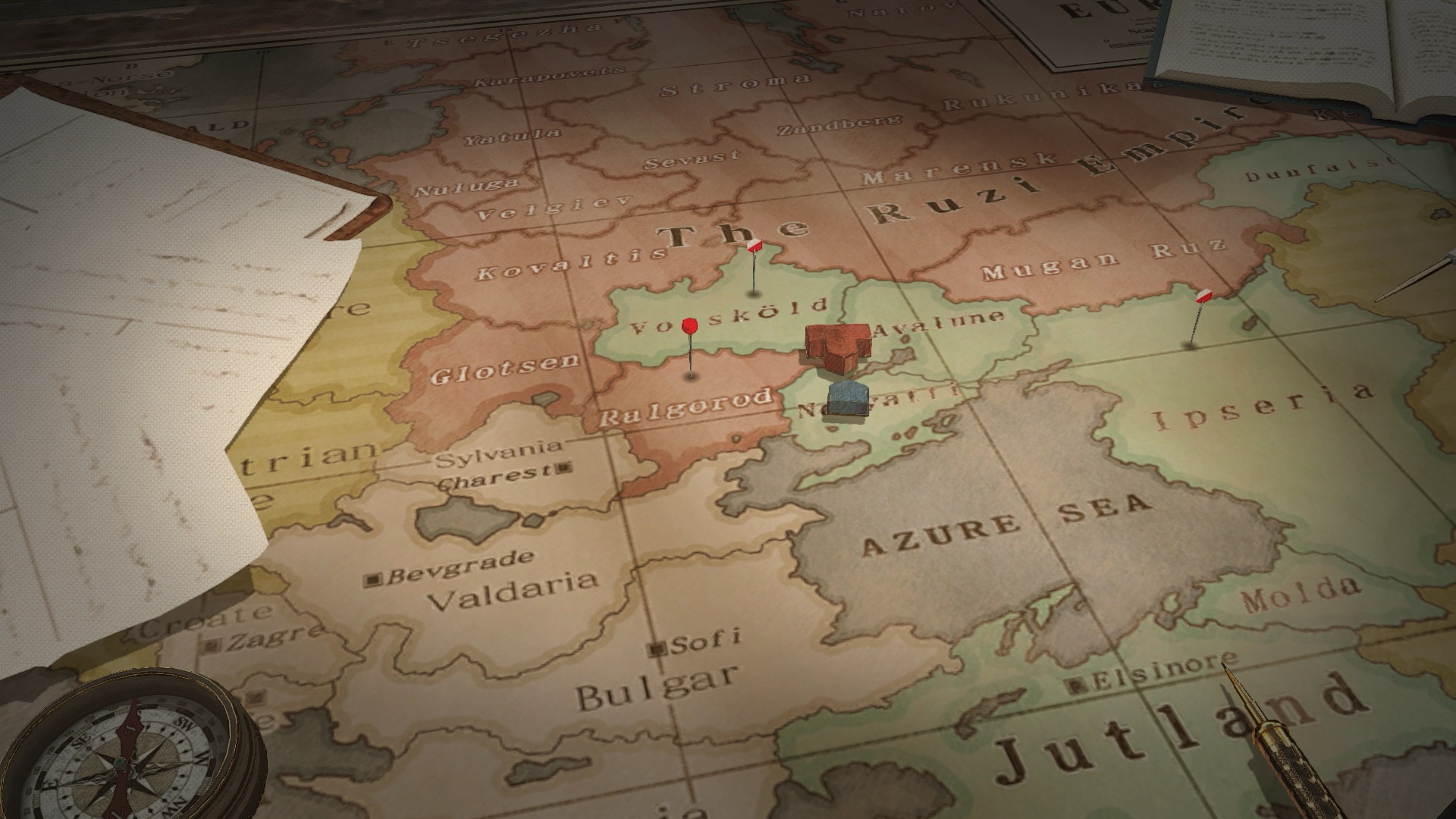Return to console
While we recently got a remastered version of Valkyria Chronicles for the PlayStation 4, Valkyria Revolution marks the first real return to console for the Valkyria Chronicles series. But as the game’s title already hints at, this isn’t actually a sequel to Valkyria Chronicles 3, nor is it a strategy RPG like its predecessors. Instead, Valkyria Revolution is an action-RPG which actually has very little in common with the previous games. Only the fictional mineral “Ragnite” and the legendary Valkyria themselves make a return, but even those have been altered to better fit the game’s fantasy setting.
Admittedly, it’s difficult not to draw comparisons with the original Valkyria Chronicles and Valkyria Revolution. Back when it was first released, the original Valkyria Chronicles rekindled my interest in SEGA, and while far from perfect, I think it struck a great balance in being a game with typical Japanese anime influences that nonetheless aimed for a world-wide audience. It’s a game I could recommend even to those not typically into Japanese RPGs or anime. Afterwards, I feel like the series lost that balance, as the new development team invested more heavily in anime tropes and fanservice in the game’s sequels. Valkyria Revolution isn’t the game to restore that balance, but admittedly that’s not what the developers were aiming for. That matter aside, is Valkyria Revolution a good game in its own right? Read on to find out my thoughts about the game.
Story
Valkyria Revolution‘s story takes place in a different timeline, continent, and universe from the previous games. The game’s opening scene is set in the country of Jutland, long after an event called the “Liberation War”. Standing at the grave of the “Circle of Five”, two character discuss the events that had previously led the country of Jutland to war. The “Circle of Five” were five people who were branded and executed as traitors, blamed for driving the entire country to war just so they could exact their personal revenge on the opposing Ruzi Empire’s leader. As the player, you experience the events of this war through 11 of the game’s chapters.
I can’t say my expectations for the story were very high, and much of that had to do with the quality of the cutscenes in the demos (more on that later). As such, I was pleasantly surprised to find that story is actually quite good. While the main characters Amleth and Ophelia fall into anime stereotypes far more than Welkin and Alicia did, and develop along a predictable path because of that, the overall storyline is genuinely intriguing. We learn how the “Circle of Five” managed to drive the country to war by influencing public opinion through propaganda, as well as infiltrating the country’s leadership. Following the morally questionable actions of this group of anti-heroes as the story progresses is one of the highlights of the game. Similarly, the opposing Ruzi empire gets a fair amount of attention.
Graphics, Presentation and Sound
The original Valkyria Chronicles already had fantasy elements, but much of the warfare was still grounded in a more realistic setting. With Valkyria Revolution on the other hand, we’re back to a more standard fantasy JRPG setting. Characters are now wielding impossibly huge weapons, and can use magic spells through the use of mana. The character’s outfits also abandon the more realistic uniforms from VC1. While I’m not really a fan of these new designs, the attention to detail for each character’s outfit is commendable, and matches their personality quite well.
One thing I had hoped to see with the series’ return to console was an evolution of Valkyria Chronicles‘s CANVAS graphics engine, which offered a watercolor painting-like style to the game. Valkyria Revolution‘s “Gouache” graphics engine is designed to achieve a similar effect, but here it feels more like it’s just a filter overlayed on top of the screen. Underneath, everything looks rather similar to Media.Vision’s other SEGA game, Shining Resonance. While the graphics are for the most part more detailed in textures, it never quite manages to deliver the hand-drawn look of the original VC. It’s certainly far from what I’d expect to see from a CANVAS 2.0, given the 9 year gap between both games.
Much of the time I spent playing the time was looking at the lengthy cutscenes in between battles. and unfortunately that’s also an area where the game doesn’t perform well. Despite promises that these were a work-in-progress, little or no progress was made in the release version compared to the demos. Characters look very stilted in cutscenes, and their faces don’t allow for much expression at all. Lip synching is limited, and again inferior to that of Valkyria Chronicles.
What I find puzzling is that the game doesn’t use the 2D/3D visual novel-like cutscene presentation from the original Valkyria Chronicles. Instead, the developers opted to display full 3D scenes, but in doing so we get to see awkward scenes where the developers tried to hide the character’s faces while they’re talking, either by viewing them from the back, from far-away or by simply having them talk off-screen. Much if this actually feels like a step down from the original Valkyria Chronicles.
Graphically, the game is a mixed bag. Areas like the Promenade look impressive, but the quality in the missions varies greatly, with some areas looking particularly washed out. While the graphics are displayed at a 1080P resolution, there’s some noticeable aliasing and shimmering that drags down the overall image quality. The framerate seems locked at 30fps, unlike Valkyria Chronicles Remastered‘s 60fps framerate. Note that I’m running the game on a PS4 Pro, and I have yet to compare it to a regular PS4. Even so, I don’t expect to see much of a difference.
The one thing that does stand out is the soundtrack, composed by Yasunori Mitsuda, The use of a live symphony and vocals by Sarah Àlainn doesn’t go unnoticed, and it’s one area where it rivals anything the series have put forward so far.
Gameplay
In their press releases leading up to the game’s release, SEGA argued that Valkyria Revolution features a “faster-paced (but no less strategic) combat” system. Unfortunately, having played through much of the game, I can’t say I agree with the statement. Back when the first demo was revealed, the Japanese fans offered some harsh criticism to the game’s action-based system. In response, the developers tried to infuse more strategy elements into the game. But asking for fan feedback is not necessarily the smartest thing to do, and I imagine it was already an early sign that the developers simply weren’t confident about what they were doing. By forcing strategy elements into the game in the hopes of catering to demands from fans of the original games, they ended up creating a game that really doesn’t do either the action or the strategy aspect very well.
In battle, the game allows you to control a party of four characters, which you can pick out of a larger cast before you start a mission. Each character belongs to a different class, with their own strengths and weaknesses. During a mission, you have direct control over one of the 4 characters in your team, with the option to switch between them. The other characters are AI controlled, although you have some control over the actions they should take (for example, switching to support/defense/offense).
Every character has access to basic actions (using your main weapon), but also to special skills (ragnite, items, guns, grenades, …) accessed via a battle template interface. However, using those actions feels slow and tedious compared to other recent action-RPGs. After using an action, you need to wait for the character’s action gauge to refill. Depending on the class, this leaves an annoying downtime where you’re essentially doing nothing, performing an action, again doing nothing, and so on. While this downtime can be reduced or outright removed at times, I really have to wonder why it’s even there to begin with.
And while you can switch between characters, order the rest of your team to focus on support/offense and pause to use special skills, most of the game doesn’t really challenge you to use any of them. On the game’s Normal difficulty (the highest one can select when first playing the game), the clueless AI simply doesn’t offer much of a challenge, and as a result the victories don’t feel very rewarding. Every mission ends up feeling the same as a result. So far, I’ve yet to see a Game Over screen, or fail to rescue a downed party member within the allowed 60 seconds (the game is supposed to have perma-death if you fail to rescue them within that allotted time). Only the bosses require a bit more effort, but most of that is just because of their high health that allows them to soak up damage.
Localization
Recently, Persona 5’s localization was criticized for its poor grammar and inconsistencies, and reading the many remarks from professional translators on the matter has made it even more obvious to me just how difficult the process of localizing a game really is. The fact that English isn’t my first language, combined with only a very basic knowledge of Japanese, makes me wary of commenting on the localization of Valkyria Revolution. Nonetheless, some aspects of the localization did stand out when I played the game. For example, Princess Ophelia speaks in a more sophisticated way, even using some older (Shakespearean?) English words. What also became apparent to me was that efforts were made to make certain characters speak in a more unique way, in areas where the Japanese script was a lot more basic. Even so, they still conveyed the original meaning of the Japanese dialogue. These are things Persona 5’s localization was criticized for, but in this case the translation does seem consistent.
While I mostly listened to the original Japanese dialogue, I could just as easily have listened to the English dub. The English voice actors deliver a solid performance, and unlike other games there’s little reason to switch to the Japanese dialogue here. That said, that option is still available.
Conclusion
Valkyria Revolution falters in one important area: the gameplay. The mix between action and strategy just doesn’t work well here. As much as I like the gameplay from the original games, Valkyria Revolution would have been better off had it not tried to shoehorn a strategy element in its gameplay. Coupled with the repetitive missions and poor AI, I can’t say I enjoyed playing through the game. It’s really a shame, as otherwise Valkyria Revolution’s story is interesting enough, the graphics are serviceable and it features an excellent soundtrack. It’s genuinely a missed opportunity.

